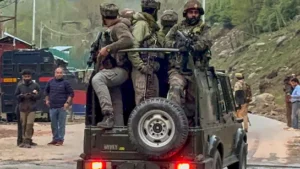Terror in Paradise: The Pahalgam Attack of 2025
Introduction
Pahalgam is a town in Kashmir that is known for its stunning natural beauty. It has wide, green valleys that stretch as far as the eye can see and offers breathtaking views of the mountains and the rivers. Many people visit every year to escape the busy cities and enjoy the tranquility of nature. It is a peaceful place where tourists can relax, go for long walks, or try activities like fishing and horse riding. The town’s charm lies in its quiet environment, which makes it a favorite spot for travelers seeking calm and scenic beauty. Over the years, Pahalgam has grown popular among domestic and foreign visitors alike. It’s seen as a safe holiday destination, offering a refreshing break from daily life. Despite its remote location, the town attracts thousands of tourists annually, eager to experience its lush landscapes and serene atmosphere. The local economy depends heavily on tourism, which supports many local shops, hotels, and guides.
However, on April 22, this peaceful haven was shattered when terrorists launched a brutal attack in Pahalgam. The violence surprised both residents and visitors, who had come to enjoy the area’s natural charm. The attack caused widespread fear and grief across the region. Emergency services responded swiftly, but the scene was chaotic and disturbing. Many questions arose about how such violence could happen in a place known for its calm and beauty. People began to worry about the safety of tourists and residents alike. The incident also cast a shadow over the region’s reputation as a peaceful destination. It raised important concerns about the security measures in place and whether more could be done to prevent such attacks. The event drew a lot of attention from national and international media, with reports overlaying the natural beauty of Pahalgam with scenes of violence and destruction.
The attack had serious consequences. Tourism, which was already showing signs of recovery after previous conflicts, took a big hit. Tourists started to cancel their trips, and new visitors grew hesitant to come. Locals feared that the region’s stability might be at risk. The government faced pressure to improve security and restore confidence among travelers. Experts pointed out that such events threaten not just the local economy but also peace in the wider area. They emphasized that lasting safety and stability are crucial for the future of Pahalgam and Kashmir.
This tragic event left many asking how violence could take root in such a calm place. It also highlighted the ongoing struggles faced by the region, where peace remains fragile. It is a reminder that even untouched and peaceful places are vulnerable to violence and unrest. The attack serves as a stark warning about the importance of stronger security measures and dialogue to keep peace. It also reminds people how quickly a moment of tranquility can turn into chaos. Moving forward, the region will need to confront these challenges and work to rebuild trust and safety. This event underscores the need for continuous efforts to protect both the natural beauty and the people who call Pahalgam home.
The Background of Pahalgam and Regional Tensions
Historical Context of Unrest in Kashmir
Conflict has raged in Kashmir for many years. India and Pakistan both claim the region as theirs. This long-standing dispute has led to many clashes and acts of violence over the years. Terrorist groups have often used unrest as a way to push political goals. This backdrop creates a tense environment that makes security a constant challenge.
Pahalgam’s Strategic and Tourism Importance
Pahalgam isn’t just about scenic beauty. It also holds economic value due to its thriving tourism industry. Many hotels, shops, and guides depend on visitors for their livelihood. Its location near borders and military installations adds to its security challenge. When tourists come, it creates a risk, but it also brings much-needed revenue to the area.
Rise in Militant Activities Leading Up to 2025
In recent years, before the attack, reports of infiltration and militant movements increased. These groups adjusted their tactics, becoming more secretive and better organized. They also formed new alliances, making them harder to track. This buildup of militant activity created an environment where an attack was becoming more likely.
Details of the 2025 Pahalgam Attack
Chronology of Events
The attack began with militants crossing the border into Kashmir. They moved stealthily through the mountains, avoiding patrols. It all happened over a few hours, but the chaos lasted much longer. Security forces responded quickly, but the damage was already done.
Perpetrators and Modes of Operation
Investigators identified the terrorist groups involved as local affiliates linked to larger networks supported from across the border. They used firearms, grenades, and explosives to carry out the assault. The terrorists aimed to inflict maximum damage and create fear among visitors and residents.
Casualties and Damage
The Pahalgam terror attack on April 22, 2025, left 26 people dead were men, including 25 Indian tourists and one Nepalese national, and injured 17 others, many of whom sustained critical wounds. The victims were caught off guard when four heavily armed militants opened fire in Baisaran Valley, a popular tourist spot accessible only on foot or horseback. Among those injured were security personnel and local pony handlers assisting the tourists.
Significant damage was also done to the local infrastructure as a result of the attack; numerous buildings were shot through, and vehicles, notably pony carts and tourist taxis, were destroyed in the ensuing confusion. The attack rocked the country, highlighting the ongoing security issues in Jammu and Kashmir and throwing a pall over recent attempts to boost travel to the area.
Responses and Security Measures Implemented
Immediate Aftermath
Rescue teams rushed victims to hospitals. The army and police launched searches to find remaining militants. The government issued statements condemning the attack and promised action. Emergency measures helped keep the situation under control, but scars remained.
Enhanced Security Protocols
Security forces increased their presence in Pahalgam and the surrounding areas. Checkpoints, patrols, and surveillance grew more intense. New technology, like high-resolution cameras and drone patrols, helped monitor suspicious activity. Intelligence sharing between agencies also improved.
Policy Changes and Strategic Shifts
In response, Indian authorities revisited border security policies. They stepped up efforts to block infiltration routes. New counter-terrorism plans focused on gathering info faster and stopping attacks before they happen. These measures aim to prevent similar incidents in the future.
The Broader Impact on Kashmir and India
Tourism Decline and Economic Effects
Many travelers decided to cancel their trips after the recent attack, leading to a sharp drop in the number of visitors. This sudden decline in tourism severely affected local businesses that rely on tourists for income. Hotels reported many rooms remaining empty, and some had to reduce staff or close their doors temporarily. Restaurants experienced fewer customers, which meant lower sales for cooks, servers, and bartenders. Small shops and market stalls also saw fewer shoppers, causing them to lose money and sometimes even face the risk of closing down. This drop in visitors had a ripple effect, hitting families who depend on tourism for their daily income. Thousands of workers found their hours cut or lost their jobs altogether. Local guides, transportation companies, and souvenir vendors felt the shutdown very hard. Many people in the community relied on tourists for their income, and this downturn created financial strain for many families. Less tourism affects more than simply the businesses. It also affects the town’s economy, as money that normally circulates through the community slows down or stops altogether. This situation leaves many wondering when tourism will pick up again and bring back hope and stability to the local economy. The attack created a sense of fear that made travelers hesitant to visit, which made the economic problems even worse. Overall, the decline in travel caused a chain reaction that hurt many lives and slowed the town’s recovery.
Political and Diplomatic Ramifications
The attack increased tensions between India and Pakistan. Both countries blamed each other and raised military alerts. The incident also drew international concern. Countries called for calm and dialogue, but deep mistrust remains.
Social and Community Tensions
Locals in Kashmir felt more anxious and worried about safety. Some communities questioned whether peace efforts were enough. Authorities launched programs to promote harmony and calm fears. Keeping community relations strong is vital during such tense times.
Lessons Learned and Future Prevention Strategies
Strengthening Intelligence and Surveillance
Sharing intelligence quickly and accurately is critical. Communities can help by reporting suspicious activity. Modern technology can catch threats early before they turn deadly.
Enhancing Regional Cooperation
The Pahalgam terror attack has once again underscored the urgent need for India and Pakistan to cooperate more effectively on counterterrorism efforts. The militants, reportedly affiliated with radical Islamist groups operating across the Line of Control (LoC), targeted civilians indiscriminately, many of whom were Hindu pilgrims and tourists. This has raised deep concerns about religiously motivated violence and the targeting of non-Muslim visitors in the region. To prevent such tragedies, both countries could pursue cross-border intelligence sharing, joint monitoring of known infiltration routes, and revived peace dialogues to dismantle the networks that thrive on hostility and division. While decades of mistrust and conflict have made collaboration difficult, such steps are essential to address the sectarian undertones of terrorism in Kashmir and move toward lasting peace in South Asia.
Conclusion
The 2025 Pahalgam attack reminds us how fragile peace can be in regions with long-standing conflicts. Protecting communities requires strong security, smart policies, and ongoing dialogue. Only through united efforts can we build a safer, more peaceful Kashmir. Everyone has a role in supporting resilience, peace, and stability for future generations.




